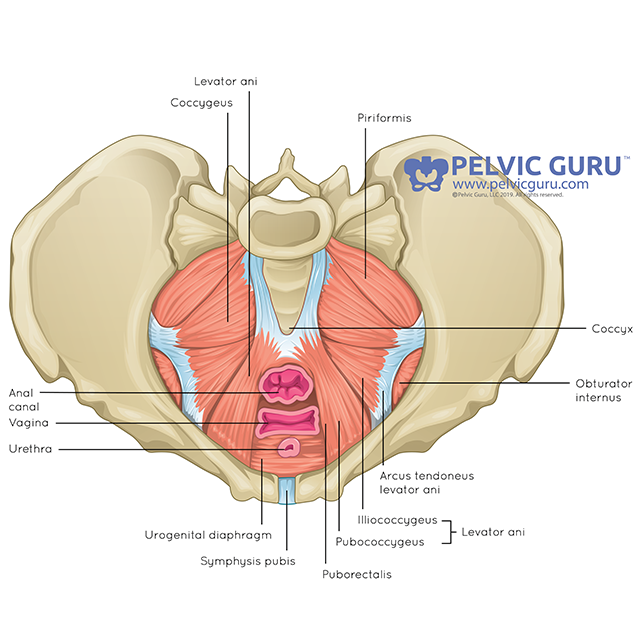What exactly is the Pelvic Floor?
Did you know that every single person has a pelvic floor? Most people were never taught anything about their pelvic floor anatomy or pelvic health, and our pelvic floor physical therapists at Foundations Pelvic Health are changing that. We are passionate about educating everyone about this part of their body!
Pelvic Floor Anatomy
Though we often refer to your pelvic floor as just a group of muscles, it contains blood vessels, fatty tissue, ligaments, tendons, nerves and fascia - all of which can play significant roles in your pelvic health. The pelvic floor is connected to the hips, pelvis, core and spine, which all helps the pelvic floor to function optimally.
The pelvic floor can be thought of as a muscular hammock at the bottom of your pelvis that your pelvic organs rest upon. For those with a vagina, the pelvic floor muscles support the bladder, uterus and rectum while the corresponding urethra, vaginal canal and anal canal run through the pelvic floor.
View of the pelvic floor muscles and the relationship to surrounding musculature.
View of the pelvic floor muscles with the pelvic organs on top. (From left to right: bladder, uterus and rectum)
Layers of the Pelvic Floor Muscles
Layer 1 | Superficial Layer
This is the layer of pelvic floor muscles that is closest to the skin, and they are responsible for sexual function and arousal. They also operate to help with closure of the pelvic openings - such as urethra and vagina.
Layer 2 | Middle Layer
The next layer lies deeper to the superficial layer, and also functions to help with urethral closure.
Layer 3 | Deepest Layer
This set of muscles is the innermost layer, containing the levator ani muscle group. The role of these deep muscles is to provide support for the pelvic organs by lifting.
What does the Pelvic Floor do?
The pelvic floor muscles have a lot of responsibilities. This set of muscles performs the FIVE S’s:
Stability: The pelvic floor muscles help to stabilize your pelvis from the inside out
Support: Our pelvic floor muscles act as a muscular hammock to support the pelvic organs
Sphincteric: The urethra and rectum contain sphincters, allowing us to have control over our urinary system and bowel function.
Sexual: Our pelvic floor muscles play a huge role in sexual functioning and arousal
Sump Pump: The pelvic floor muscles act as a pump for blood and lymphatic fluid, helping to reduce inflammation in the pelvis
Movements of the Pelvic Floor
For decades, women were told to ‘do your kegels’ - unfortunately, this is not the only movement that the pelvic floor should be able to perform!
Kegels, or ‘pelvic floor contraction’, is when the pelvic floor contracts inwards and upwards - as if you’re stopping the flow of pee (don’t do this while you’re actually trying to pee). While pelvic floor contractions are important for general pelvic health, they shouldn’t be the only pelvic floor exercise you do.
Pelvic floor relaxations is when the pelvic floor muscles ‘lengthen’ - meaning that the muscles relax downward like you’re spreading your sits bones. Pelvic floor relaxations can be more important than kegels!
An image that might be helpful:
Imagine that your pelvic floor muscles are like your biceps muscle - when you bend your elbow to ‘make a muscle’, that’s similar to a pelvic floor contraction. When you relax or straighten your elbow, that’s your pelvic floor muscle relaxation/lengthening.
The Importance of Breathing and your Pelvic Floor
Your pelvic floor and breathing are very much connected! Your pelvic floor PT will be able to teach you how to coordinate these, and apply it to your movements and exercise.
On inhalation, your diaphragm moves downward, your abdominals relax, and your pelvic floor also relaxes downward.
On exhalation, your diaphragm moves upward, your abdominals contract, and your pelvic floor muscles contract inward and upward.
Pelvic floor muscle assessment:
To examine the pelvic floor muscles, your pelvic floor PT is able to perform an internal assessment. We examine each layer of the pelvic floor, starting from the most superficial layer to the deepest layer, and also assess for the following:
Determine your pelvic floor muscle’s ability to contract (kegel) and relax
Assess for pelvic floor muscle coordination
Check for skin irritations or anatomical changes
Measure pelvic floor muscle strength and range of motion
Evaluate for areas of tightness or restrictions
Pelvic Floor Therapy at Foundations Pelvic Health
We help with issues such as:
urinary leakage, urinary retention, urinary frequency, urinary urgency, prolapse
Constipation, hemorrhoids, fecal incontinence
Vaginismus, dyspareunia, vulvar pain, difficulty with orgasm, perineal pain
Endometriosis, pre-/post-gynecological surgery
Pregnancy and postpartum recovery
labor and delivery preparation, SIJ pain, pubic symphysis pain (SPD), back pain, diastasis recti, prolapse
At our Boston pelvic floor therapy office, we specialize in helping women improve their pelvic health. As our visits are always one-on-one and one-hour long, our pelvic floor PTs are able to dedicate the time to educate you on your pelvic floor and pelvic health, perform a detailed assessment, and create a custom, individualized plan for you!




